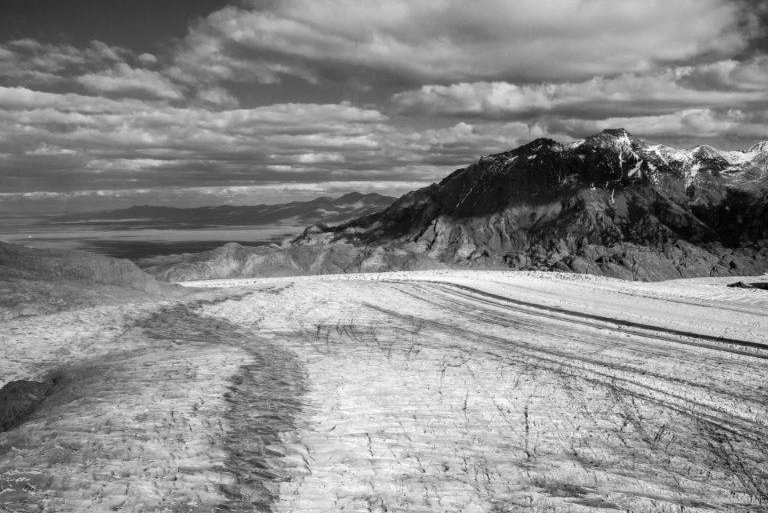Patagonia's ice sheets are more massive than scientists thought
June 4, 2019
By Brooks Hays

The ice fields stretching across South America’s Patagonia region, including Argentina’s Viedma Glacier, are thicker than scientists previously estimated.
Photo by Jeremie Mouginot / UCI
June 4 (UPI) -- A seven-year survey of Patagonia's ice suggests the slabs of ice that stretch across vast portions of Argentina and Chile are thicker than scientists thought, measuring more than a mile in thickness in some places.
"We did not think the ice fields on the Patagonian plateau could be quite that substantial," Eric Rignot, professor of earth sciences at the University of California, Irvine, said in a news release. "As a result of this multinational research project, we found that -- added together -- the northern and southern portions of Patagonia clearly hold more ice than anticipated, roughly 40 times the ice volume of the European Alps."
Measurements collected using satellite radar altimetry and optical imagery suggest most of Patagonia's ice sheets have been rapidly thinning during the past few decades. Outside of Antarctica, Patagonia's ice fields are the largest in the Southern Hemisphere. But as the glacial reserves in Argentina and Chile melt, water drains into the ocean, fueling sea level rise.
In order to better understand the region's potential contribution to sea level rise, scientists wanted to more accurately characterize the size of Patagonia's ice sheets.
"This is why having accurate maps of the ice thickness is a priority," said Romain Millan, who is now a postdoctoral scholar at the Institute of Environmental Geosciences in France but worked on the survey as a graduate student at UCI. "It is fundamental to get the right contours and depth of the glacial valleys; otherwise, simulations of glacier retreat will always be wrong."
Sounding techniques can only be used on the shallowest portions of Patagonia's ice fields, and because almost all of the region's ice exists at temperatures close to its melting point, the sheet's water content is unusually high, making measurements using radar less effective.
Scientists conducted the newly concluded seven-year survey using gravimeters, flown in airplanes high above the surface of the ice. After dozens of flights, scientists used the gravitational field measurements to map the ice thickness. The findings -- published in the journal Geophysical Research Letters -- showed Patagonia's ice is much thicker than previous studies suggested.
If the the planet continues to warm and Patagonia's ice continues to melt, the region could contribute more to global sea level rise than scientists previously anticipated.

 www.upi.com
www.upi.com
June 4, 2019
By Brooks Hays
The ice fields stretching across South America’s Patagonia region, including Argentina’s Viedma Glacier, are thicker than scientists previously estimated.
Photo by Jeremie Mouginot / UCI
June 4 (UPI) -- A seven-year survey of Patagonia's ice suggests the slabs of ice that stretch across vast portions of Argentina and Chile are thicker than scientists thought, measuring more than a mile in thickness in some places.
"We did not think the ice fields on the Patagonian plateau could be quite that substantial," Eric Rignot, professor of earth sciences at the University of California, Irvine, said in a news release. "As a result of this multinational research project, we found that -- added together -- the northern and southern portions of Patagonia clearly hold more ice than anticipated, roughly 40 times the ice volume of the European Alps."
Measurements collected using satellite radar altimetry and optical imagery suggest most of Patagonia's ice sheets have been rapidly thinning during the past few decades. Outside of Antarctica, Patagonia's ice fields are the largest in the Southern Hemisphere. But as the glacial reserves in Argentina and Chile melt, water drains into the ocean, fueling sea level rise.
In order to better understand the region's potential contribution to sea level rise, scientists wanted to more accurately characterize the size of Patagonia's ice sheets.
"This is why having accurate maps of the ice thickness is a priority," said Romain Millan, who is now a postdoctoral scholar at the Institute of Environmental Geosciences in France but worked on the survey as a graduate student at UCI. "It is fundamental to get the right contours and depth of the glacial valleys; otherwise, simulations of glacier retreat will always be wrong."
Sounding techniques can only be used on the shallowest portions of Patagonia's ice fields, and because almost all of the region's ice exists at temperatures close to its melting point, the sheet's water content is unusually high, making measurements using radar less effective.
Scientists conducted the newly concluded seven-year survey using gravimeters, flown in airplanes high above the surface of the ice. After dozens of flights, scientists used the gravitational field measurements to map the ice thickness. The findings -- published in the journal Geophysical Research Letters -- showed Patagonia's ice is much thicker than previous studies suggested.
If the the planet continues to warm and Patagonia's ice continues to melt, the region could contribute more to global sea level rise than scientists previously anticipated.

Ice sheets in Patagonia are more massive than scientists thought - UPI.com
The slabs of ice that stretch across vast portions of Argentina and Chile are bigger and thicker than scientists thought, according to a seven-year survey of Patagonia's ice.
